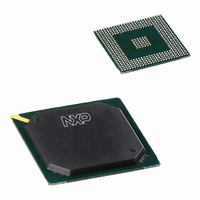PNX1502E,557 NXP Semiconductors, PNX1502E,557 Datasheet - Page 171

PNX1502E,557
Manufacturer Part Number
PNX1502E,557
Description
IC MEDIA PROC 300MHZ 456-BGA
Manufacturer
NXP Semiconductors
Specifications of PNX1502E,557
Applications
Multimedia
Core Processor
TriMedia
Controller Series
Nexperia
Interface
I²C, 2-Wire Serial
Number Of I /o
61
Voltage - Supply
1.23 V ~ 1.37 V
Operating Temperature
0°C ~ 85°C
Mounting Type
Surface Mount
Package / Case
456-BGA
Lead Free Status / RoHS Status
Lead free / RoHS Compliant
Program Memory Type
-
Ram Size
-
Lead Free Status / Rohs Status
Not Compliant
Other names
935274744557
PNX1502E
PNX1502E
PNX1502E
PNX1502E
Available stocks
Company
Part Number
Manufacturer
Quantity
Price
Company:
Part Number:
PNX1502E,557
Manufacturer:
NXP Semiconductors
Quantity:
10 000
- Current page: 171 of 828
- Download datasheet (8Mb)
Philips Semiconductors
Volume 1 of 1
PNX15XX_SER_3
Product data sheet
2.11.1 Setting GPIO[14:12]/GCLOCK[2:0] as Clock Outputs
2.11.2 GPIO[6:4]/CLOCK[6:4] as Clock Outputs
2.11 GPIO Clocks
2.12 Clock Block Diagrams
protecting an input clock from contention by having the pad set to an input (in the
case of an input clock). In both cases a write to each control register is necessary to
properly put the clock into an input or output configuration (otherwise the logic will
remain in the quasi-input/output mode).
As indicated above VDO_CLK1 can either be QVCP or LCD. After reset the clocks
are in the above mentioned quasi-input/output mode. If it is to be LCD then the
qvcp_out control register must be programmed to “separate” output mode. If the LCD
only bit (bit 31 in the LCD_SETUP MMIO register) is set then the output select bit in
the qvcp_out control register cannot be written to a ‘1’ (feedback mode). The LCD
mode register can only be written to once and then only to disable LCD mode. If this
is done then the output select bit can be programmed to any value.
The folowing sections present the sequence of actions required to enable clocks on
the GPIO[12:14,6:4’ pins.
The following sections present the block diagrams of the different clocks generated by
the Clock module.
•
•
•
•
•
•
•
•
•
•
Set gpio pin to gpio mode 2 using GPIO_MODE_0_15
Set gpio pin to output a 0 using GPIO_MASK_IOD_0_15
Set dds frequency using DDSx_CTL
Enable dds output to clk_gpio_y using CLK_GPIO_y_CTL
page
Enable clk_gpio_y to pin using DDS_OUT_SEL
Set gpio pin to gpio mode 2 using GPIO_MODE_0_15
Set gpio pin to output a 0 using GPIO_MASK_IOD_0_15
Set dds frequency using DDSx_CTL
Enable dds output to clk_gpio_y using CLK_GPIO_y_CTL
page
Set GPIO_EV_x.EN_DDS_SOURCE = 1 and GPIO_EV_x.CLOCK_SEL = 4 for
GPIO[4], 5 for GPIO[5] and 6 for GPIO[6]
5-34)
5-34)GPIO_EV_x.
Rev. 3 — 17 March 2006
(Table 11 on page
(Table 11 on page
(Table 10 on page
(Table 16 on page
Chapter 5: The Clock Module
© Koninklijke Philips Electronics N.V. 2006. All rights reserved.
PNX15xx Series
(Table 7 on page
(Table 7 on page
5-34)
5-34)
(Table 8 on page
(Table 8 on page
(Table 11 on
(Table 11 on
8-27)
8-36)
8-24)
8-24)
8-26)
8-26)
5-20
Related parts for PNX1502E,557
Image
Part Number
Description
Manufacturer
Datasheet
Request
R
Part Number:
Description:
Digital Signal Processors & Controllers (DSP, DSC) MEDIA PROCESSOR PNX15XX/300MHZ
Manufacturer:
NXP Semiconductors

Part Number:
Description:
IC MEDIA PROC 300MHZ 456-BGA
Manufacturer:
NXP Semiconductors
Datasheet:
Part Number:
Description:
NXP Semiconductors designed the LPC2420/2460 microcontroller around a 16-bit/32-bitARM7TDMI-S CPU core with real-time debug interfaces that include both JTAG andembedded trace
Manufacturer:
NXP Semiconductors
Datasheet:

Part Number:
Description:
NXP Semiconductors designed the LPC2458 microcontroller around a 16-bit/32-bitARM7TDMI-S CPU core with real-time debug interfaces that include both JTAG andembedded trace
Manufacturer:
NXP Semiconductors
Datasheet:
Part Number:
Description:
NXP Semiconductors designed the LPC2468 microcontroller around a 16-bit/32-bitARM7TDMI-S CPU core with real-time debug interfaces that include both JTAG andembedded trace
Manufacturer:
NXP Semiconductors
Datasheet:
Part Number:
Description:
NXP Semiconductors designed the LPC2470 microcontroller, powered by theARM7TDMI-S core, to be a highly integrated microcontroller for a wide range ofapplications that require advanced communications and high quality graphic displays
Manufacturer:
NXP Semiconductors
Datasheet:
Part Number:
Description:
NXP Semiconductors designed the LPC2478 microcontroller, powered by theARM7TDMI-S core, to be a highly integrated microcontroller for a wide range ofapplications that require advanced communications and high quality graphic displays
Manufacturer:
NXP Semiconductors
Datasheet:
Part Number:
Description:
The Philips Semiconductors XA (eXtended Architecture) family of 16-bit single-chip microcontrollers is powerful enough to easily handle the requirements of high performance embedded applications, yet inexpensive enough to compete in the market for hi
Manufacturer:
NXP Semiconductors
Datasheet:

Part Number:
Description:
The Philips Semiconductors XA (eXtended Architecture) family of 16-bit single-chip microcontrollers is powerful enough to easily handle the requirements of high performance embedded applications, yet inexpensive enough to compete in the market for hi
Manufacturer:
NXP Semiconductors
Datasheet:
Part Number:
Description:
The XA-S3 device is a member of Philips Semiconductors? XA(eXtended Architecture) family of high performance 16-bitsingle-chip microcontrollers
Manufacturer:
NXP Semiconductors
Datasheet:

Part Number:
Description:
The NXP BlueStreak LH75401/LH75411 family consists of two low-cost 16/32-bit System-on-Chip (SoC) devices
Manufacturer:
NXP Semiconductors
Datasheet:

Part Number:
Description:
The NXP LPC3130/3131 combine an 180 MHz ARM926EJ-S CPU core, high-speed USB2
Manufacturer:
NXP Semiconductors
Datasheet:

Part Number:
Description:
The NXP LPC3141 combine a 270 MHz ARM926EJ-S CPU core, High-speed USB 2
Manufacturer:
NXP Semiconductors

Part Number:
Description:
The NXP LPC3143 combine a 270 MHz ARM926EJ-S CPU core, High-speed USB 2
Manufacturer:
NXP Semiconductors

Part Number:
Description:
The NXP LPC3152 combines an 180 MHz ARM926EJ-S CPU core, High-speed USB 2
Manufacturer:
NXP Semiconductors











